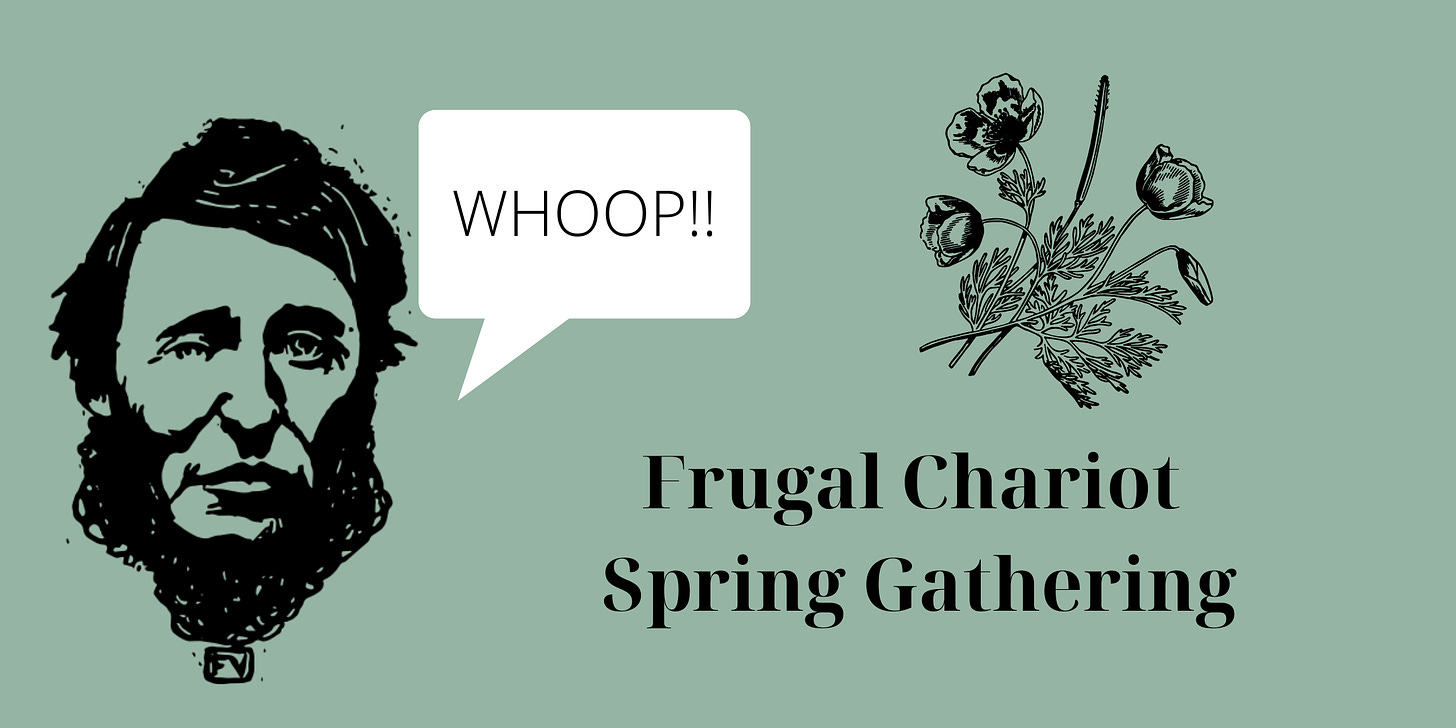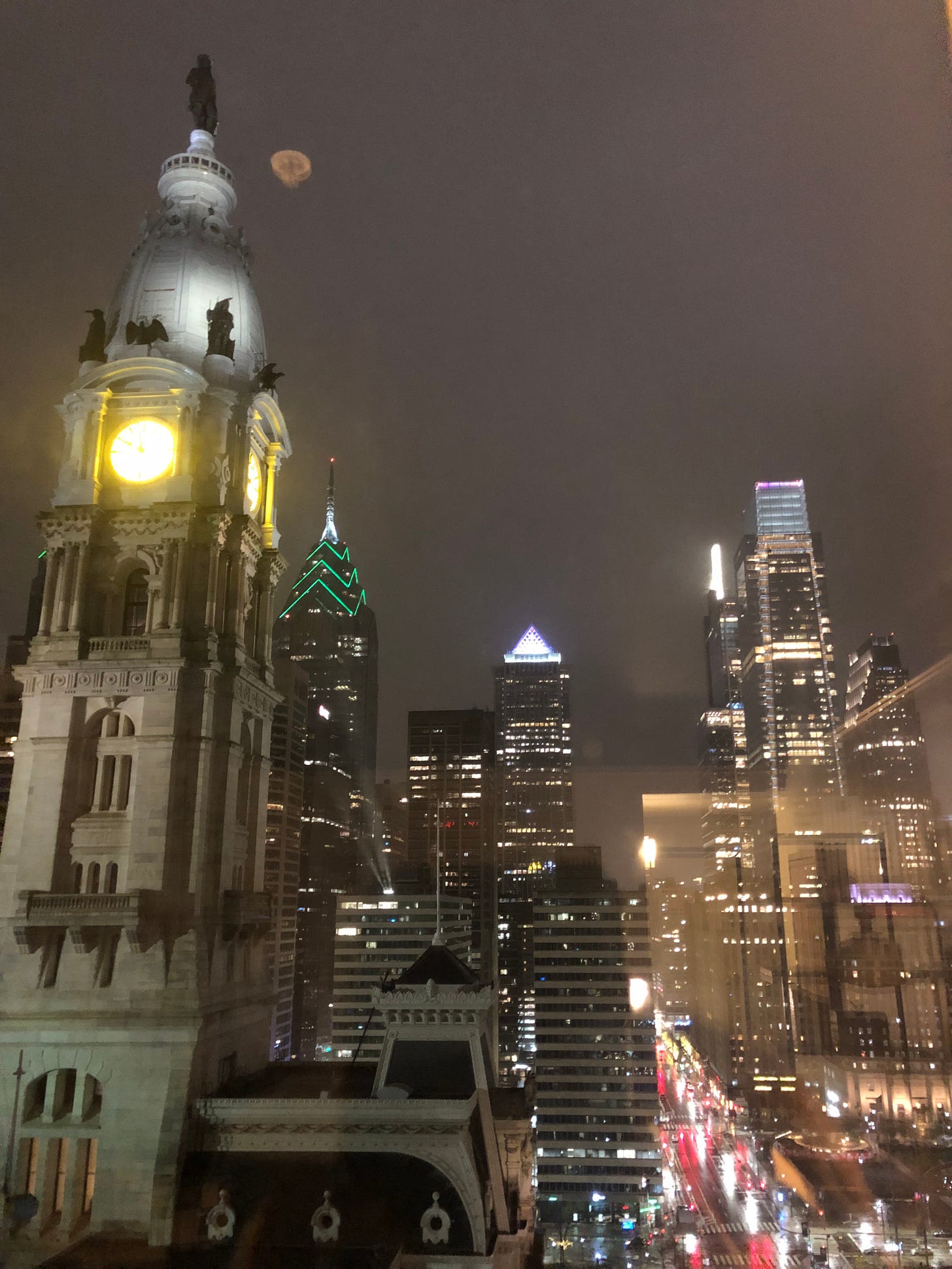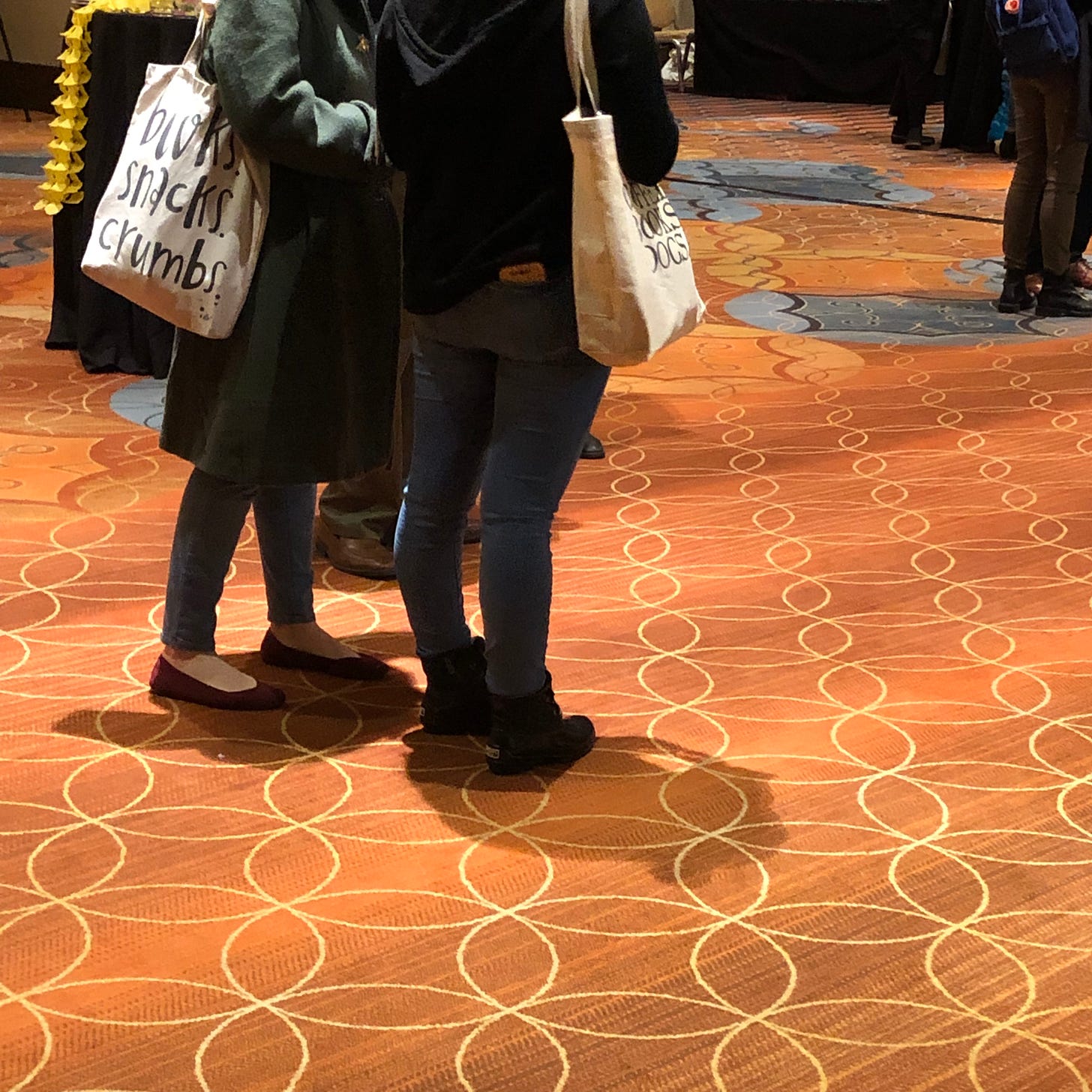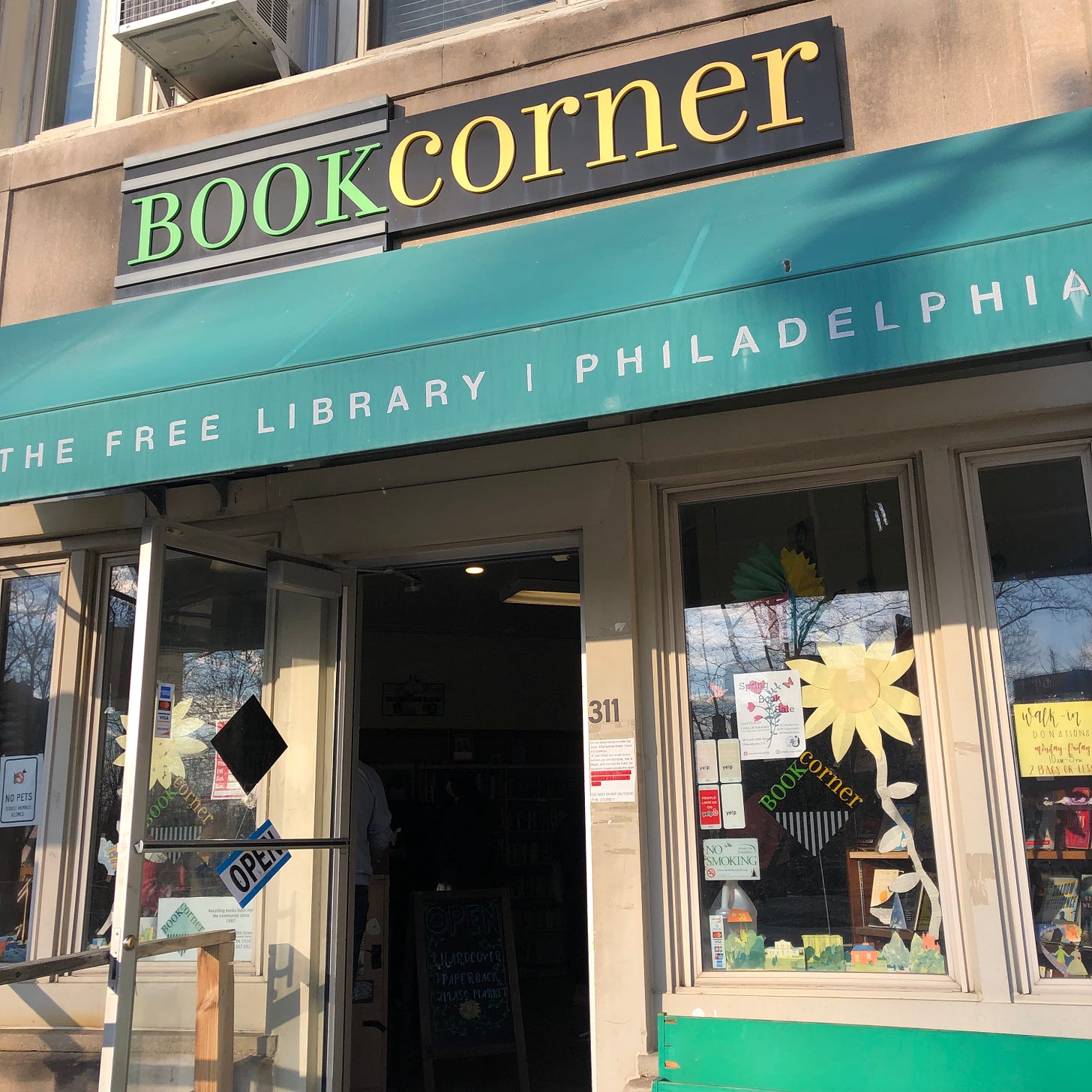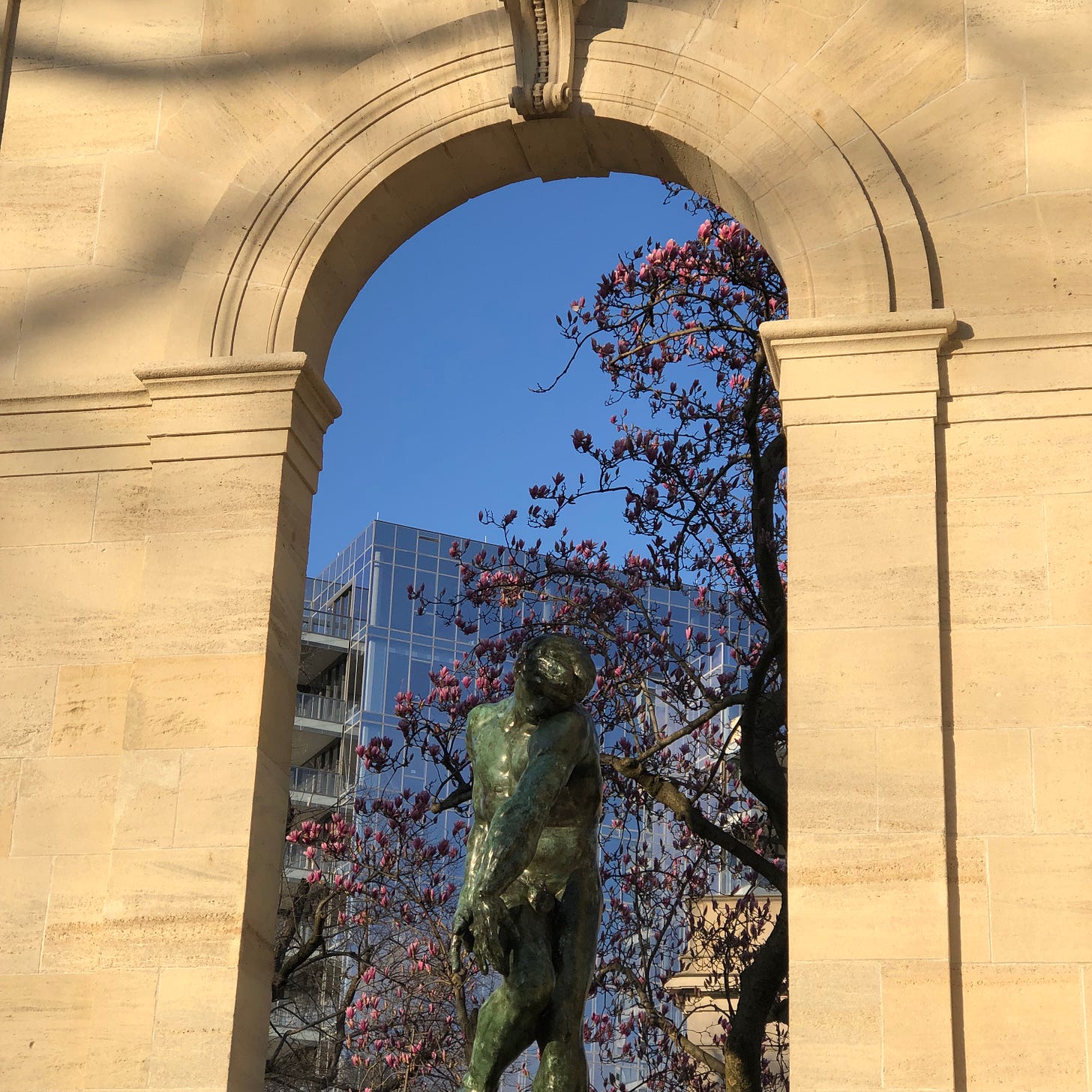Dear Reader,
First up, a gentle reminder that tomorrow brings our equinoctial jamboree, a celebration of the vibrant legacy of Henry David Thoreau (on Zoom). How often do you get to welcome Spring in company with a Pulitzer Prize winner, a writer/artist with a new book, and one of the world’s leading experts in forest ecosystems? This chance is yours at 4 P.M. Eastern — but you’ll need to register in advance at this link. Hope to see you there!
Greetings from Philadelphia, where I am full of the sisterly, brotherly, and otherly love of 8,000+ literati, who have converged here this week for an in-person gathering of the Association of Writers and Writing Programs. The AWP is the umbrella association for degree-granting programs in creative writing, as well as the extensive literary ecosystem that goes along with them. It has been quite an experience to be around so many other humans for the first time since the pandemic began. We are all masking and distancing in graceful fashion, and hugging according to mutual comfort levels. There have been panels and parties and readings and coffee meet-ups and tote bags, and an exhibition hall crammed with indie publishers, august journals, experimental zines, and groups that serve special communities like veterans and kids.
Instead of posting a review this week, I’ve decided to highlight several of the authors who have spoken at the conference, and in particular to share various thoughts from some of the environmental and nature writers who have presented. I’d like to dedicate this issue to my paid subscribers, who so kindly provided the support that got me to Philadelphia this week. Thank you from my heart.
Field Notes: Voices from AWP 2022
Lacy Johnson is the author of Trespasses and The Other Side, two memoirs about the aftermath of sexual violence. She lives in Houston and has recently been writing about the aftermath of Hurricane Harvey, for a forthcoming book titled More City Than Water: A Houston Flood Atlas. The work will offer a series of cartographic explorations of Houston’s flooding patterns, combined with reflections from a range of Houston residents. Johnson ventured this thought as she opened a panel on “Writing Disaster”:
What language exists to make meaning of a disaster when the disaster becomes less like an event with a beginning and ending and more like a tide — it ebbs and flows; our relationship to the world erodes as it arrives and arrives and arrives.
And also this:
The circumstances that create disastrous conditions occur when a hazard (like a hurricane or a tornado in an urban area on the Gulf Coast) exceeds our capacity to address it — that is to say, a disaster happens when hazards encounter our vulnerabilities, which are socially constructed. The climate crisis, taken as a disastrous whole, is not just the consequence of burning fossil fuels and adding carbon to the atmosphere. That creates the conditions for hazards — hurricanes and wildfires and unprecedented winter storms — but those hazards create disasters when they meet the vulnerabilities created by the violent ways we relate to one another and to the world. Disaster isn’t the weather — it just makes visible a violence that is always felt but is usually obscured from view.
Kerri Arsenault is the author of Mill Town, which is at once a memoir, a history, and an environmental investigation of her home town in Maine. She made this observation:
We need stories, not just information, data, science, news. We need our stories to contain love, enchantment, complexity, plot, characters, better verbs. Our work is not reaching the bookshelves of those whom our work needs to reach, a broader audience, leaders, politicians, those who do not think like us or agree with us, those who make laws.
Emily Raboteau, author of Searching for Zion, spoke about her motivation to write about the climate disaster as a parent who believes:
Intergenerational justice is the work of the moment. Some kinds of writing are morally impossible — anything solipsistic. How could such negligence be forgiven by those will follow us?
I sincerely recommend Raboteau’s essay “Climate Signs” in the New York Review of Books.
Cinelle Barnes is the author of several books including Monsoon Mansion, a memoir of her childhood in the Philippines. She is currently at work on a book entitled Rematriate, about the gendered impact of environmental crises. This will be a consideration of indigenous matriarchial power structures in places like Palawan, cultural frameworks that offer potential models for healing ecosystems and human communities post-disaster.
I'm . . . intentional about who I perceive or imagine as my audience when I'm writing about disasters. A lot of disaster-relief and advocacy copy and literature is written for a mass — which is an assumed-white — audience. I write my nonfiction specifically for Filipino/a/x communities, especially calling to attention and action Filipinas in the diaspora who don't yet understand that disasters, the climate crisis, and water inequality could very well lead to us not having a motherland to physically go home to. Disasters are a form of erasure of history and identity.
The very island she is writing about was hit by a devastating typhoon in December, 2021.
Kazim Ali is the author of Northern Light: Power, Land, and the Memory of Water. In this memoir he returns to the small town in Northern Manitoba where he grew up, to learn about the disastrous environmental consequences of a hydroelectric dam project, and to investigate the harm it brought to local indigenous communities. In his remarks, he spoke about how indigenous elders believe that rivers and streams are like the veins in a leaf, and that dams harm everything around them, including humans. Ali also put forward the idea of landscape as a clock that marks time as it changes. It made me think of the hands of the clock that are spinning as humans accelerate climate processes.
Lucille Lang Day, a poet and publisher of Wampanoag descent, observed:
For indigenous peoples worldwide, the earth is sacred, and as a result, traditional cultures exist sustainably with nature. You don’t dam the sacred rivers, clear-cut the sacred forests, cut the tops off sacred mountains, or hunt the earth’s sacred creatures to extinction. These things are unthinkable.
Most recently, Day is the co-author of Poetry and Science: Writing Our Way to Discovery.
The confluence of scientific and indigenous ways of knowing (see also Frugal Chariot 1 and Frugal Chariot 2) was also taken up by former Poet Laureate of Wisconsin Kimberly Blaeser, who is Anishinaabe. Blai offered this poem:
The Where in My Belly
Scientists say my brain and heart
are 73 percent water—
they underestimate me.A small island—minis, I emerged
among Minnesota’s northern lakes,
the where of maanomin—wild rice in my belly.I am from boats and canoes and kayaks,
from tribal ghosts who rise at dawn
dance like wisps of fog on water.My where is White Earth Nation
and white pine forests,
knees summer stained with blueberries,
pink lady slippers open and wild as my feet.I grew up where math was Canasta,
where we recited times tables
while ice fishing at twenty below,
spent nights whistling to Northern Lights.I am from old: medicines barks and teas;
from early—the air damp with cedar
the crack of amik, beaver tails on water.Their echo now a warning to where—
to where fish become a percentage of mercury,
become a poison statistic;
to where copper mines back against
a million blue acres of sacred.I am from nibi and ogichidaakweg
women warriors and water protectors,
from seed gatherers and song makers.the wet where pulse in my belly whispers and repeats
like the endless chant of waves on ledgerock
waves on ledgerock on ledgerock on waves
on water . . . nibi
When was the last time that I rode an escalator? It has been strange to spend so much time talking about the environment within the sanitized and carpeted built environment of a convention center. Yet as Kazim Ali astutely remarked, the city is a natural environment. Everything is natural. We are nature. Cities may be mostly human-made, but they are so much more than human. The city is an ecosystem both denuded of and burgeoning with life, from pigeons and microbiota to — probably — the COVID-19 virus bits from which we were all diligently trying to shield ourselves and each other, with our KN95s and our elbow bumps.
I felt unexpected updrafts of joy while wandering through the book fair and speaking with publishers about their books: a history of the American Chestnut, a weird Japanese forest fable, an anthology of the Anthropocene translated from eight different languages. So many writers and publishers and educators are devoting themselves to our desperate predicament.
After the second day of the conference, I took a long walk from my hotel to the Liberty Bell, and then on to the Philadelphia Museum of Art and back. It was too late to visit any of the museums, but I did nip into the venerable Book Corner used book shop just before closing time—and for $3.18, I managed to nab a copy of David Abram’s classic The Spell of the Sensuous. This is a truly profound text of ecological aesthetics and moral philosophy. Abram asserts: “We are human only in contact, and conviviality, with what is not human.” It felt so good to converge with other humans who share this conviction.
See you tomorrow on Zoom and next week in your inbox. xo Nicie




